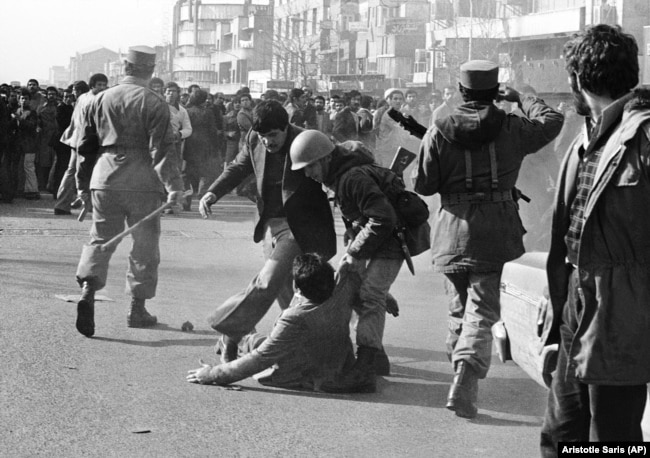Radiofarda – Former revolutionary says Khomeini won because Shah’s army refrained from killing people.
In a series called “Forty Years, Forty Interviews,” Radio Farda’s Farhang Ghavimi is sitting down with 40 prominent Iranians who played a role in events leading up to the Islamic Revolution 40 years ago. In a recent episode, he spoke with former Islamic revolutionary and anti-monarchy activist Mohsen Sazegara, who was in the employ of Ayatollah Ruhollah Khomeini while the 78-year-old cleric and later founder of the Islamic Republic was in exile in France. After the revolution, the young Sazegara helped create the charter for the Islamic Revolutionary Guards Corps (IRGC), the branch of the armed forces officially tasked with protecting the revolution.
Despite his role in the founding of the Islamic Republic, Sazegara eventually began calling for a reform of the system and was arrested in 2003 during the presidency of Mohammad Khatami. He spent 114 days in prison, 79 of them on hunger strike, before being released due to his fragile health. Sazegara then left Iran legally to seek medical treatment in the UK before permanently settling in the U.S., where he currently lives in voluntary exile.
When the first murmurs of revolution began in 1978, the 23-year-old Sazegara was living as a student in Chicago, Illinois. He says that a few days after Khomeini left Najaf, Iraq for Paris and later a village called Neufle-le-Chateau in France, Sazegara was summoned by one of Khomeini’s close allies to help in the movement to overthrow Shah Mohammad Reza Pahlavi.
Having been an anti-monarchy activist since his high school years in Iran, Sazegara did not hesitate to accept the offer to work for the mysterious cleric galvanizing the anti-Shah forces.
“When I arrived, Khomeini’s base in Neufle-le Chateau had turned into an organized headquarters of the revolution,” Sazegara remembers, adding that Khomeini, then known as the Imam, was constantly holding interviews with international journalists with the help of his translators. The idea was to portray the Imam as the “savior” set to rescue Iran from tyranny and replace it with a rosy future based on justice, fraternity, and equality.
Nonetheless, no one in Neufle-le-Chateau believed the Shah’s regime would fall easily.
“Even Khomeini did not imagine that the Shah’s regime was going to easily collapse within three or four months. All of us thought that we were going to experience a long, Vietnam style guerrilla war against the imperial army,” Sazegar said. “We started recruiting volunteers from among the Iranians who visited Khomeini for military and subversive training.”
Sazegara insists that nobody, save himself, Khomeini, and his Texas-educated aide and interpreter Ebrahim Yazdi knew about the secret recruitment.
“I would brief the volunteers in three to four daily sessions on subversive tactics,
clandestine military operations, sabotage actions, and then send them to the Middle East for further training,” Sazegara said.
In the end, the volunteers didn’t need to fire a single shot, as the regime collapsed much sooner than the revolutionaries could have hoped.
“The Shah made several mistakes, and this allowed the revolution to prevail so easily,” said Sazegara. “The Shah’s army refrained from killing people. Its personnel simply stood idly by, watching people pouring into the streets, demonstrating, and chanting slogans against the Shah. Had they shot a number of the protesters, ordinary people would return to their homes, leaving a handful of adventure seeking youth to confront one of the strongest armies of the world at the time.”
Despite his calls for revolution, Khomeini’s French visa was renewed, reportedly with the Shah’s consent.
According to Sazegara, Khomeini, through his trusted ally Ebrahim Yazdi (later the Islamic Republic’s Foreign Minister), began holding secret talks with U.S. representatives, assuring them that Iran would not join the Soviet Bloc.
“We had four or five secret sessions with one of the U.S. State Department’s directors in a small motel next to Khomeini’s residence in Neufle-le-Chateau, answering to his inquiries about the future of Iran; will the communists take over, whether the next regime is going to be in the anti-Western camp, etc,” Sazegara said. “He was assured that none of these outcomes were expected by the revolutionaries.”
Looking back at four decades of the Islamic Revolution and the ruling system dominated by clerics that emerged from it, Sazegara regretfully admits he has decided the Islamic Republic cannot be reformed and will have to be abolished.
 Shabtabnews In this dark night, I have lost my way – Arise from a corner, oh you the star of guidance.
Shabtabnews In this dark night, I have lost my way – Arise from a corner, oh you the star of guidance.




